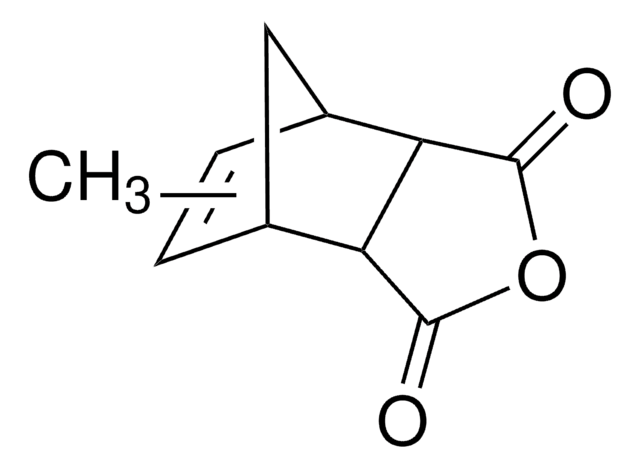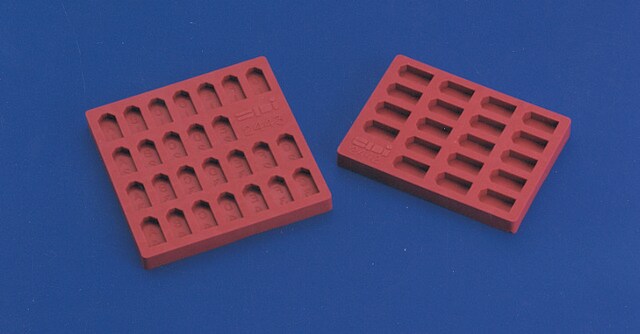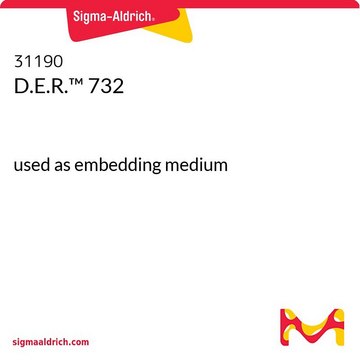EM0300
Spurr Low Viscosity Embedding Kit
hydrophobic resin for embedding histological samples
Synonim(y):
resin for specimen preparation
Zaloguj sięWyświetlanie cen organizacyjnych i kontraktowych
About This Item
Kod UNSPSC:
12171500
NACRES:
NA.47
Polecane produkty
Zastosowanie
hematology
histology
temp. przechowywania
room temp
Opis ogólny
Spurr resin is a hydrophobic resin. It is less viscous than epon mixtures and is easier to dispense. The low viscosity of the resin contributes to its penetration in tissue, mineral and dense structures. A low viscosity of 60 cps also allows easy penetration into a variety of difficult materials.
Zastosowanie
Exceptional penetration for tissue, mineral, and dense structures. A low viscosity of 60 cps allows easy penetration into a variety of difficult materials. Spurr low viscosity embedding kit has been used to embed histological samples like tissues, organs and embryos. It may be used to prepare mineral specimens for polishing. The low viscosity of the Spurr formulation allows rapid infiltration into tissues, minerals, and other dense structures.
Ta strona może zawierać tekst przetłumaczony maszynowo.
Tylko elementy zestawu
Numer produktu
Opis
- Nonenylsuccinic anhydride 450 g
- D.E.R. 736 250 g
- Dimethylaminoethanol 100 g
- ERL 4221 250 g
Hasło ostrzegawcze
Danger
Zwroty wskazujące rodzaj zagrożenia
Zwroty wskazujące środki ostrożności
Klasyfikacja zagrożeń
Acute Tox. 3 Inhalation - Acute Tox. 4 Dermal - Acute Tox. 4 Oral - Eye Dam. 1 - Flam. Liq. 3 - Muta. 2 - Skin Corr. 1B - STOT SE 3
Organy docelowe
Respiratory system
Kod klasy składowania
3 - Flammable liquids
Temperatura zapłonu (°F)
102.2 °F
Temperatura zapłonu (°C)
39 °C
Wybierz jedną z najnowszych wersji:
Masz już ten produkt?
Dokumenty związane z niedawno zakupionymi produktami zostały zamieszczone w Bibliotece dokumentów.
Klienci oglądali również te produkty
Frederick J Warren et al.
The Plant journal : for cell and molecular biology, 84(3), 634-646 (2015-09-25)
Infrared microspectroscopy is a tool with potential for studies of the microstructure, chemical composition and functionality of plants at a subcellular level. Here we present the use of high-resolution bench top-based infrared microspectroscopy to investigate the microstructure of Triticum aestivum L.
Gergely Hegyi et al.
The Journal of experimental biology, 221(Pt 9) (2018-04-05)
Structural plumage colour is one of the most enigmatic sexually selected traits. The information content of structural colour variation is debated, and the heterogeneity of the findings is hard to explain because the proximate background of within-species colour differences is
A routine method for embedding animal tissues in Spurr resin for electron microscopy.
Wallis M A and R L Griffin
Journal of Clinical Pathology, 26(1), 77-77 (1973)
Samir Dekali et al.
Toxicology, 365, 1-8 (2016-08-01)
DWCNTs have numerous industrial and biomedical applications and several studies reported that they could act as immunomodulator systems. The immune system is the first line of defence of the human body when exposed to particulate matter. In order to investigate
Sara Abolhassani Rad et al.
Plant signaling & behavior, 13(10), e1517075-e1517075 (2018-09-27)
AROGENATE DEHAYDRATASE2 (ADT2) is a member of the Arabidopsis thaliana ADT family. All members of this family act as arogenate dehydratases in phenylalanine biosynthesis, decarboxylating/dehydrating arogenate to phenylalanine. ADT2 is detected in stromules, and as a ring around the equatorial
Nasz zespół naukowców ma doświadczenie we wszystkich obszarach badań, w tym w naukach przyrodniczych, materiałoznawstwie, syntezie chemicznej, chromatografii, analityce i wielu innych dziedzinach.
Skontaktuj się z zespołem ds. pomocy technicznej











